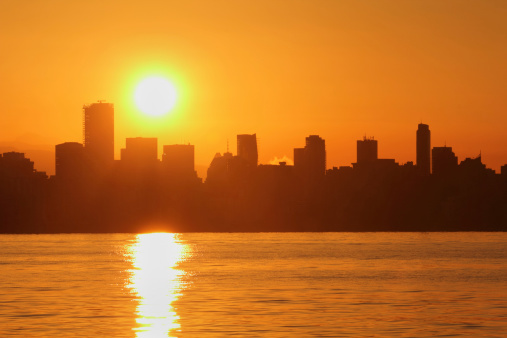Climate Change Weekly #162
Robert (Bob) M. Carter, Ph.D., professor and head of the School of Earth Sciences at James Cook University in Queensland, Australia between 1981 and 1999, has penned a careful analysis of the attempt to slander noted solar and scientist Dr. Willie Soon of the Harvard-Smithsonian Center for Astrophysics.
Climate alarmists have been unable to refute Dr. Soon’s research into climate models and the influence of the sun on climate change, so they have stooped to attempted character assassination.
Since 2011, Greenpeace staffer Kert Davies has been peddling to anyone who would listen allegations that Dr. Soon’s research was biased by money the Smithsonian received from the fossil-fuel industry. Davies’ claims had no takers until Dr. Soon co-authored a paper in the journal Science Bulletin promoting a climate model more simple and more reflective of the real world than the models used by the United Nations’ Intergovernmental Panel on Climate Change. The paper proved immensely popular, downloaded more than 22,000 times since its publication in January 2015. The Boston Globe, and within two weeks The New York Times, then used Davies’ material to cast aspersions on Dr. Soon.
In the aftermath of the Times‘ report, the Smithsonian announced it was conducting an investigation into whether Dr. Soon had properly disclosed any possible conflicts-of-interest he may have had when publishing his research.
It’s odd the Smithsonian would deem it necessary to undertake such an inquiry. At the Center for Astrophysics, all proposed scientific work must be pre-approved by division heads and by the office of the Smithsonian’s director. No grant is accepted until both it and the purpose of the research is approved by the director.
As Carter explains,
The “Statement of Values and Code of Ethics” of the Smithsonian Institution signifies that the institution itself provides the oversight to prevent any undue influence by outside parties (such as donors or sponsors) on any scholarship or publications that stem from externally donated funds. That statement includes the following:
The Smithsonian adheres to professional standards and best practices in seeking and accepting support from these [outside] sources to ensure that fundraising activities support the Smithsonian mission and protect the Smithsonian’s reputation, integrity, and independence, while regarding donors and sponsors with the highest level of respect and establishing relationships characterized by forthrightness and honesty.
The provision of this assurance that there is no conflict of interest between donors and researchers, along with other management services, is why the Smithsonian deducts approximately 30 to 40 percent of any external grant to cover its own overhead costs. From the remainder, the grantee must pay their own stipend, as well as any necessary research assistance, equipment, and other costs. As a working scientist, Dr. Soon has no authority to sign a research contract to receive a grant, let alone to decide and dictate the terms of such contracts.
Because the grants are always strictly between the Smithsonian and the funders, Dr. Soon’s signature is not on any of the contracts between donors and the Smithsonian Institution to support his research. It is therefore the Smithsonian that carries the responsibility for accepting and properly administering the external payments that support Dr. Soon’s work.
Dr. Soon and other working scientists like him are paid by the Smithsonian, not by the external funder, to carry out those duties. Simply put, Dr. Soon is employed by the Smithsonian to conduct research paid for by external grants obtained by the Smithsonian.
All of this is undisputed, so why the need for an inquiry? If Dr. Soon is in some way penalized by the Smithsonian, it can only be because the institution is using him as a convenient scapegoat, not because of any wrongdoing on his part.
And all of this is beside the point. As Carter points out, in science, the method itself is the best insurance of accuracy and honesty. He writes, “Science is different from politics or commerce in that who pays for a piece of research – whether it should be Genghis Khan or Mother Teresa – is simply irrelevant to making judgments about the validity of the research product, which stands or falls depending upon its consistency with the facts and the ability of other scientists to independently confirm the result.”
What matters is not who pays for the research or even any personal bias of the researcher. It’s the results that matter: Are they accurate? Are they replicable?
Truth, not profit or power, is the currency of science.
Or at least it was, until some climate researchers, political scientists, biologists, ecologists, and others found out how much funding would flow to them and how much influence they could wield if only they could stoke a perpetual state of alarm over the changing climate. The media needs crises to sell papers, ad space, and airtime, and politicians and bureaucrats need problems to “solve” to justify their ever-expanding domains. Honest researchers like Dr. Soon threaten to derail the gravy train.
— H. Sterling Burnett
SOURCES: The Heartland Institute
IN THIS ISSUE …
Antarctic ice contradicts climate models … Record cold undermines warming theory … Conflict not linked to climate … Natural variability cools and warms … Climate skepticism before it was cool
ANTARCTIC ICE CONTRADICTS CLIMATE MODELS
According to a new study in the journal The Cryosphere, climate model predictions concerning sea ice in Antarctica have been dead wrong. Examining the projections of 49 climate models used by the United Nations’ Intergovernmental Panel on Climate Change, the Chinese researchers found on average the models predicted a substantial decline in Antarctic sea ice from 1979 through 2005, yet sea ice extent actually grew. And since 2005, Antarctic sea ice has repeatedly shattered sea-ice extent records, recently setting a new record for sea-ice extent during the middle of summer. Only eight of the 49 models projected a modest growth in sea ice and none predicted record-setting growth.
SOURCE: The Cryosphere

RECORD COLD UNDERMINES WARMING THEORY
In the early 2000s, David Viner, a senior research scientist at the University of East Anglia’s Climatic Research Unit, stated within a few years winter snowfall will become “a very rare and exciting event. Children just aren’t going to know what snow is.” And the Intergovernmental Panel on Climate Change stated very clearly: “Milder winter temperatures will decrease heavy snowstorms.” Since those pronouncements, heavier snowfall and colder temperatures have become the winter norm. Thousands of cold temperature records have been broken in the past two years and the U.S. has cooled over the past decade, while temperatures have stalled globally. In an attempt at damage control, many climate alarmists are now arguing warmer temperatures actually cause colder temperatures and more snow, exactly the opposite of what they claimed just a short time ago. Heartland Institute Senior Fellow James M. Taylor summed things up nicely: “Global warming alarmists are selling snake oil.”
SOURCES: Forbes.com and Weather Bulletin 8
CONFLICT NOT LINKED TO CLIMATE
For more than a decade, climate alarmists have claimed global warming will contribute to increased conflict, primarily due to competition for scarce resources. The conflicts cited as examples of the phenomenon are located in areas known for frequent conflict prior to the current warming period and also for historical patterns of extreme climates similar to those seen today. While some observers attributed Egypt’s Arab Spring in part to climate change causing food shortages, Egypt’s agricultural output had increased during the years before the conflict. Globally, looking at temperature trends and conflicts over the past half-century one finds no correlation between rising temperatures and armed conflicts or deaths in conflicts. Since 1976, through both the 1998 peak rise in temperature and the current pause, interstate warfare has seen a steady decline. Civil war or intrastate conflict rose sharply through the early 1990s, falling precipitously thereafter. Over the same period, the number of deaths due to conflict fell, rose, and fell again with a significant decline in deaths overall. In short, neither conflicts in general, nor any particular conflict, can be linked to global warming.
SOURCE: The Lukewarmer’s Way
NATURAL VARIABILITY COOLS AND WARMS
Roy Spencer, Ph.D., a co-recipient of NASA’s Exceptional Scientific Achievement Medal for his work monitoring global temperature with satellites, notes one of the leading explanations for the ongoing pause in global warming is a natural but unaccounted for change in ocean circulation suppressing the rise in temperatures. Spencer notes if a change in ocean circulation has negated anthropogenic warming in the past 15+ years, an opposite change likely enhanced warming during the 1970s to 1990s. “You can’t have one without the other,” Spencer writes. “Natural fluctuations in ocean vertical circulation are cyclical. You can’t attribute the recent warming hiatus to natural forcings without also addressing the role of potential natural forcings in causing the previous warming period. At best, it betrays a bias in reasoning; at worst, it is logically inconsistent. This is not just a minor detail that is irrelevant to long-term climate predictions because the models were mostly developed (and modelers’ opinions regarding sensitivity formed) during a period (the 1970s to 1990s) when substantial natural warming was occurring, yet they assumed it was entirely manmade.”
SOURCES: Global Warming blog and Asia-Pacific Journal of Atmospheric Sciences
CLIMATE SKEPTICISM BEFORE IT WAS COOL
A new paper shows pioneers in the study of climate were largely skeptics, while “their heirs quickly grasped that sound science doesn’t pay half as well as a good scare story.” For example, Robert White, chairman of the first World Climate Conference in 1979, was concerned politics was getting ahead of the science, warning in 1989 of an “inverted pyramid of knowledge [where] a huge and growing mass of proposals for policy action is balanced upon a handful of real facts.”
A number of early leaders in the area of climate research were set adrift by their research institutions when their skepticism concerning the human influence on climate became public. Others remained silent until career pursuits no longer mattered. Joanne Simpson, the first woman awarded a Ph.D. in meteorology and the first female president of the American Meteorological Society, declared upon her retirement: “Since I am no longer affiliated with any organization nor receive any funding, I can speak quite frankly. For more than a decade now ‘global warming’ and its impacts [have] become the primary interface between our science and society. A large group of earth scientists, voiced in an IPCC statement, have reached what they claim is a consensus of nearly all atmospheric scientists that man-released greenhouse gases are causing increasing harm to our planet. … However, the main basis of the claim that man’s release of greenhouse gases is the cause of the warming is based almost entirely upon climate models. We all know the frailty of models concerning the air-surface system. No one seems to have properly factored in population growth and land use, particularly in tropical and coastal areas. … But as a scientist I remain skeptical.”
Robert Jastrow, founding director of NASA’s Goddard Institute of Space Studies (GISS), recognized Earth was experiencing a general warming trend, arguing the cause was likely due to natural factors. Jastrow resigned in 1981 and James Hansen, godfather of the global warming scare, replaced him. Within a year, Hansen reoriented GISS’s work from doing basic research in space sciences to highlighting threats from global warming.
SOURCES: Quadrant and Global Warming Science





